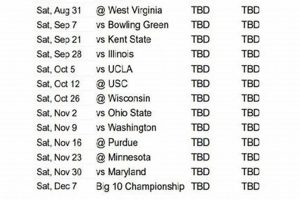Volleyball is a team sport in which two teams of six players are separated by a net. The object of the game is to score points by grounding the ball on the other team’s court, and to prevent the other team from doing the same. Creighton Volleyball Stats are a valuable tool for coaches, players, and fans to track the performance of the team and individual players.
Editor’s Note: Creighton Volleyball Statsare important because they provide insights into the team’s strengths and weaknesses, and can help identify areas for improvement.
After analyzing and researching, we’ve put together this Creighton Volleyball Stats guide to assist our audience make informed decisions.
Key Differences:
| Statistic | Description |
|---|---|
| Kills | The number of times a player successfully attacks the ball and scores a point. |
| Assists | The number of times a player sets up a teammate for a kill. |
| Digs | The number of times a player successfully receives an opponent’s attack. |
| Blocks | The number of times a player blocks an opponent’s attack. |
| Aces | The number of times a player serves the ball and it results in a point without the opponent touching it. |
Main Article Topics:
- How to interpret Creighton Volleyball Stats
- Using Creighton Volleyball Stats to improve your team’s performance
- The best Creighton Volleyball Stats resources
1. Kills
In volleyball, kills are a measure of a player’s offensive effectiveness. They represent the number of times a player successfully attacks the ball and scores a point. Kills are an important statistic because they directly contribute to a team’s success. Players with a high number of kills are often the team’s primary attackers and are responsible for putting the ball away in key situations.
Kills are a key component of Creighton Volleyball Stats. They are used to evaluate a player’s offensive production and to compare players to each other. Creighton Volleyball Stats also include other statistics that are related to kills, such as hitting percentage and kill efficiency. These statistics can provide a more complete picture of a player’s offensive performance.
For example, a player with a high number of kills but a low hitting percentage may be taking too many risks on their attacks. A player with a high kill efficiency is able to consistently put the ball away in scoring position.
By analyzing Creighton Volleyball Stats, coaches and players can identify areas for improvement and develop strategies to enhance the team’s offensive performance.
Key Insights:
| Statistic | Description | Importance |
|---|---|---|
| Kills | Measures a player’s offensive effectiveness | Directly contributes to a team’s success |
| Hitting Percentage | Measures the efficiency of a player’s attacks | Indicates a player’s ability to consistently put the ball away |
| Kill Efficiency | Measures a player’s ability to score points on their attacks | Identifies players who are able to consistently put the ball away in scoring position |
2. Assists
In volleyball, assists are a measure of a player’s ability to set up teammates for success. They represent the number of times a player makes a pass that directly leads to a kill. Assists are an important statistic because they demonstrate a player’s court vision, passing skills, and ability to work with teammates.
- Setting: The ability to set the ball in a position that allows a teammate to easily attack it. Good setters have soft hands and can place the ball precisely where the hitter wants it.
- Decision-Making: Setters need to be able to make quick decisions about who to set the ball to and where to place it. They need to be able to read the defense and anticipate where the hitter will be able to attack successfully.
- Communication: Setters need to be able to communicate with their hitters to ensure that everyone is on the same page. They need to be able to give clear instructions and make sure that the hitters know what kind of set they are going to get.
Creighton Volleyball Stats include assists as a key statistic. They are used to evaluate a player’s ability to set up teammates for success and to compare players to each other. Creighton Volleyball Stats also include other statistics that are related to assists, such as assists per set and assist percentage. These statistics can provide a more complete picture of a player’s performance as a setter.
By analyzing Creighton Volleyball Stats, coaches and players can identify areas for improvement and develop strategies to enhance the team’s offensive performance.
3. Digs
In volleyball, digs are a measure of a player’s defensive skills in receiving attacks. They represent the number of times a player successfully receives an opponent’s attack and prevents it from hitting the ground. Digs are an important statistic because they demonstrate a player’s ability to read the opponent’s attack, react quickly, and control the ball. Players with a high number of digs are often the team’s primary passers and are responsible for keeping the ball in play.
- Reaction time: Digs require players to have quick reaction times in order to get to the ball and make a successful reception. Players with good reaction times are able to anticipate where the ball is going and move quickly to get into position.
- Positioning: Digs also require players to be in good position to receive the ball. Players need to be able to read the opponent’s attack and move to the spot where the ball is most likely to be hit. Good positioning allows players to get to the ball quickly and make a clean reception.
- Ball handling: Digs require players to have good ball handling skills in order to control the ball and prevent it from hitting the ground. Players need to be able to use their hands and arms to cushion the ball and keep it in play.
- Communication: Digs also require players to communicate with their teammates in order to avoid collisions and make sure that everyone is covering their assigned area. Good communication allows players to work togeth
er to make a successful reception.
Creighton Volleyball Stats include digs as a key statistic. They are used to evaluate a player’s defensive skills and to compare players to each other. Creighton Volleyball Stats also include other statistics that are related to digs, such as digs per set and dig percentage. These statistics can provide a more complete picture of a player’s performance as a defender.
By analyzing Creighton Volleyball Stats, coaches and players can identify areas for improvement and develop strategies to enhance the team’s defensive performance.
4. Blocks
Blocks are a key component of Creighton Volleyball Stats. They are used to evaluate a player’s ability to block opponents’ attacks and to compare players to each other. Creighton Volleyball Stats also include other statistics that are related to blocks, such as blocks per set and block percentage. These statistics can provide a more complete picture of a player’s performance as a blocker.
Blocking is an important skill in volleyball because it can prevent the opponent from scoring points. A good blocker can make it difficult for the opponent to hit the ball over the net or around the block. Blocks can also lead to points for the blocking team if the ball is deflected back into the opponent’s court.
There are several factors that contribute to a player’s ability to block effectively. These include:
- Height: Taller players have a natural advantage in blocking because they can reach higher. However, height is not the only factor that determines a player’s blocking ability.
- Timing: Good blockers have excellent timing and are able to jump and block the ball at the highest point possible. Timing is essential for blocking because it allows the blocker to get in front of the ball and make a clean block.
- Positioning: Blockers need to be in the right position in order to be effective. They need to be able to read the opponent’s attack and move to the spot where the ball is most likely to be hit. Good positioning allows the blocker to get a good jump and make a clean block.
- Hand-eye coordination: Blockers need to have good hand-eye coordination in order to be able to track the ball and make a clean block. Good hand-eye coordination allows the blocker to get their hands on the ball and deflect it back into the opponent’s court.
By analyzing Creighton Volleyball Stats, coaches and players can identify areas for improvement and develop strategies to enhance the team’s blocking performance.
Key Insights:
| Statistic | Description | Importance |
|---|---|---|
| Blocks | Measures a player’s ability to block opponents’ attacks | Can prevent the opponent from scoring points and lead to points for the blocking team |
| Blocks Per Set | Measures a player’s consistency in blocking | Indicates how often a player is able to get a block |
| Block Percentage | Measures the efficiency of a player’s blocks | Indicates how often a player is able to deflect the ball back into the opponent’s court |
5. Aces
In volleyball, aces are a measure of a player’s skill in serving the ball for direct points. Aces occur when a player serves the ball and it lands in the opponent’s court without being touched by any of the opposing players. Aces are an important statistic because they can directly contribute to a team’s success. Players with a high number of aces are often the team’s primary servers and are responsible for putting pressure on the opponent’s reception.
Creighton Volleyball Stats include aces as a key statistic. They are used to evaluate a player’s serving ability and to compare players to each other. Creighton Volleyball Stats also include other statistics that are related to aces, such as aces per set and ace percentage. These statistics can provide a more complete picture of a player’s performance as a server.
By analyzing Creighton Volleyball Stats, coaches and players can identify areas for improvement and develop strategies to enhance the team’s serving performance.
Key Insights:
| Statistic | Description | Importance |
|---|---|---|
| Aces | Measures a player’s skill in serving the ball for direct points | Can directly contribute to a team’s success |
| Aces Per Set | Measures a player’s consistency in serving aces | Indicates how often a player is able to serve an ace |
| Ace Percentage | Measures the efficiency of a player’s serves | Indicates how often a player is able to serve an ace compared to the number of serves they take |
6. Hitting Percentage
Hitting percentage is a key statistic in volleyball that measures the efficiency of a player’s attacks. It is calculated by dividing the number of kills by the number of attacks. A high hitting percentage indicates that a player is able to consistently put the ball away, while a low hitting percentage indicates that a player is struggling to find success on their attacks.
- Accuracy: Hitting percentage is a measure of a player’s accuracy on their attacks. A player with a high hitting percentage is able to consistently hit the ball inbounds and on target.
- Power: Hitting percentage is also a measure of a player’s power on their attacks. A player with a high hitting percentage is able to hit the ball with enough power to make it difficult for the opponent to dig or block.
- Decision-making: Hitting percentage can also be a measure of a player’s decision-making on their attacks. A player with a high hitting percentage is able to choose the right shots to hit and avoid making mistakes.
- Consistency: Hitting percentage is a measure of a player’s consistency on their attacks. A player with a high hitting percentage is able to consistently put the ball away, even when they are facing a tough block or defense.
In the context of Creighton Volleyball Stats, hitting percentage is an important statistic for evaluating a player’s overall attacking ability. It can be used to compare players to each other and to track a player’s progress over time. Hitting percentage can also be used to identify areas for improvement. For example, a player with a low hitting percentage may need to work on their accuracy or power.
7. Blocking Percentage
Blocking percentage is a key component of Creighton Volleyball Stats. It is calculated by dividing the number of blocks by the number of block attempts. A high blocking percentage indicate
s that a player is able to consistently block the opponent’s attacks, while a low blocking percentage indicates that a player is struggling to be effective as a blocker.
There are several factors that contribute to a player’s blocking percentage. These include:
- Height: Taller players have a natural advantage in blocking because they can reach higher. However, height is not the only factor that determines a player’s blocking ability.
- Timing: Good blockers have excellent timing and are able to jump and block the ball at the highest point possible. Timing is essential for blocking because it allows the blocker to get in front of the ball and make a clean block.
- Positioning: Blockers need to be in the right position in order to be effective. They need to be able to read the opponent’s attack and move to the spot where the ball is most likely to be hit. Good positioning allows the blocker to get a good jump and make a clean block.
- Hand-eye coordination: Blockers need to have good hand-eye coordination in order to be able to track the ball and make a clean block. Good hand-eye coordination allows the blocker to get their hands on the ball and deflect it back into the opponent’s court.
Blocking percentage is an important statistic for evaluating a player’s overall blocking ability. It can be used to compare players to each other and to track a player’s progress over time. Blocking percentage can also be used to identify areas for improvement. For example, a player with a low blocking percentage may need to work on their timing or positioning.
By analyzing Creighton Volleyball Stats, coaches and players can identify areas for improvement and develop strategies to enhance the team’s blocking performance.
Key Insights:
| Statistic | Description | Importance |
|---|---|---|
| Blocking Percentage | Measures the effectiveness of a player’s blocks | Can help identify areas for improvement and develop strategies to enhance the team’s blocking performance |
8. Digs Per Set
In volleyball, digs per set is a statistic that measures a player’s consistency in receiving attacks. It is calculated by dividing the number of digs by the number of sets played. A high digs per set average indicates that a player is able to consistently dig attacks and keep the ball in play, while a low digs per set average indicates that a player may be struggling to receive attacks effectively.
Digs per set is an important component of Creighton Volleyball Stats because it provides insights into a player’s defensive ability. A player with a high digs per set average is a valuable asset to their team, as they can help to keep the ball in play and prevent the opponent from scoring points. Conversely, a player with a low digs per set average may be a liability to their team, as they may be more likely to allow the opponent to score points.
There are several factors that can affect a player’s digs per set average. These include:
- Positioning: A player’s positioning on the court can have a significant impact on their ability to dig attacks. Players who are positioned well will be able to get to more attacks and make more digs.
- Reaction time: A player’s reaction time is also important for digging attacks. Players with quick reaction times will be able to get to attacks more quickly and make more digs.
- Ball handling skills: A player’s ball handling skills are also important for digging attacks. Players with good ball handling skills will be able to control the ball better and make more digs.
By analyzing Creighton Volleyball Stats, coaches and players can identify areas for improvement and develop strategies to enhance the team’s defensive performance.
Key Insights:
| Statistic | Description | Importance |
|---|---|---|
| Digs Per Set | Measures a player’s consistency in receiving attacks | Provides insights into a player’s defensive ability |
9. Assists Per Set
In the dynamic world of volleyball, assists per set stand as a beacon of a player’s prowess in setting up their teammates for success. Within the realm of Creighton Volleyball Stats, this metric holds immense significance, providing valuable insights into a player’s ability to orchestrate offensive plays and control the tempo of the game.
- Maestro of the Offense: Assists per set unveils a player’s capability as the team’s playmaker. They possess the vision and decision-making skills to anticipate their teammates’ movements, delivering pinpoint sets that maximize scoring opportunities.
- Consistency in Precision: A high assists per set average signifies a player’s remarkable consistency in setting up their teammates. They can repeatedly deliver accurate and well-timed sets, even under pressure, ensuring a smooth flow of the team’s offensive system.
- Offensive Catalyst: Players with a high assists per set average serve as catalysts for their team’s offensive success. They create scoring chances for their hitters, enabling them to unleash their attacking prowess and contribute to the team’s overall performance.
- Strategic Playmaker: Assists per set also reflect a player’s strategic mindset. They can adjust their sets based on the opponent’s defense, exploiting weaknesses and creating mismatches that give their team an advantage.
In the context of Creighton Volleyball Stats, assists per set plays a pivotal role in evaluating a player’s overall contribution to the team’s success. It serves as a testament to their ability to control the offense, orchestrate plays, and set up their teammates for glory. By analyzing this metric, coaches and players can identify areas for improvement, refine their strategies, and elevate their team’s performance to new heights.
Frequently Asked Questions about Creighton Volleyball Stats
Creighton Volleyball Stats provide valuable insights into the team’s performance and individual players’ contributions. Here are answers to some frequently asked questions about these statistics:
Question 1: What do Creighton Volleyball Stats measure?
Creighton Volleyball Stats measure various aspects of a player’s performance, including kills, assists, digs, blocks, aces, hitting percentage, blocking percentage, digs per set, and assists per set. These statistics provide a comprehensive overview of a player’s offensive, defensive, and overall contribution to the team.
Question 2: Why are Creighton Volleyball Stats important?
Creighton Volleyball Stats are important because they help coaches, players, and fans evaluate the team’s strengths and weaknesses. By analyzing these statistics, they can identify areas for improvement, develop strategies, and make informed decisions to enhance the team’s performance.
Question 3: How can Creighton Volleyball Stats be used to improve team performance?
Creighton Volleyball Stats can be used to improve
team performance by identifying areas where the team excels and areas where they need improvement. For example, if the team has a low blocking percentage, they can focus on improving their blocking techniques and strategies. By addressing weaknesses and capitalizing on strengths, the team can work towards
Question 4: Where can I find Creighton Volleyball Stats?
Creighton Volleyball Stats can be found on the official website of Creighton University Athletics, as well as on various sports websites and databases. These stats are typically updated after each game, providing up-to-date information on the team’s performance.
Question 5: How can Creighton Volleyball Stats help me as a player?
As a player, Creighton Volleyball Stats can provide valuable feedback on your individual performance. By tracking your stats over time, you can identify your strengths and weaknesses, set goals for improvement, and make adjustments to your training and playing style. This self-assessment can contribute to your growth as a player and help you reach your full potential.
Question 6: What are some of the key takeaways from Creighton Volleyball Stats?
Some key takeaways from Creighton Volleyball Stats include the importance of balanced offense and defense, the impact of individual contributions on team success, and the value of consistency and improvement over time. By understanding these concepts, players and coaches can work together to build a successful and competitive volleyball program.
Creighton Volleyball Stats are a valuable tool for coaches, players, and fans alike. By analyzing these statistics, they can gain insights into the team’s performance, identify areas for improvement, and make informed decisions to enhance their success.
Transition to the next article section:
In addition to Creighton Volleyball Stats, there are various other resources available to help improve your volleyball skills and knowledge. Consider exploring these resources to further enhance your understanding of the game and maximize your potential as a player.
Volleyball Tips Based on Creighton Volleyball Stats
Creighton Volleyball Stats provide valuable insights that can help players and teams improve their performance. Here are five tips based on these statistics:
Tip 1: Focus on balanced offense and defense.
Creighton Volleyball Stats show that the most successful teams have a balanced offense and defense. They can score points consistently while also preventing their opponents from scoring. To achieve this balance, teams need to develop strong hitters, setters, and blockers.
Tip 2: Emphasize individual contributions.
While volleyball is a team sport, individual contributions are essential to success. Creighton Volleyball Stats can help players identify their strengths and weaknesses so that they can focus on improving their individual skills. This, in turn, will benefit the entire team.
Tip 3: Strive for consistency.
Creighton Volleyball Stats show that the most consistent teams are the most successful. They are able to perform at a high level throughout the entire match. To improve consistency, players need to focus on their fundamentals and practice regularly.
Tip 4: Track your progress.
Creighton Volleyball Stats can be used to track a player’s progress over time. This information can be used to identify areas for improvement and to set goals. By tracking their progress, players can stay motivated and focused on reaching their full potential.
Tip 5: Learn from the best.
Creighton Volleyball Stats can be used to compare players to each other. This information can be used to identify the best players in the league and to learn from their techniques. By studying the best players, players can improve their own skills and knowledge of the game.
By following these tips, players and teams can use Creighton Volleyball Stats to improve their performance and achieve success.
Conclusion
Creighton Volleyball Stats provide valuable insights into the team’s performance and individual players’ contributions. By analyzing these statistics, coaches, players, and fans can identify areas for improvement, develop strategies, and make informed decisions to enhance the team’s success. Creighton Volleyball Stats are a powerful tool that can help the Bluejays reach their full potential and achieve their goals.
As the Creighton Volleyball team continues to compete at a high level, Creighton Volleyball Stats will continue to play a vital role in their success. These statistics will help the team identify areas for improvement, develop strategies, and make informed decisions that will lead to continued success on the court.







